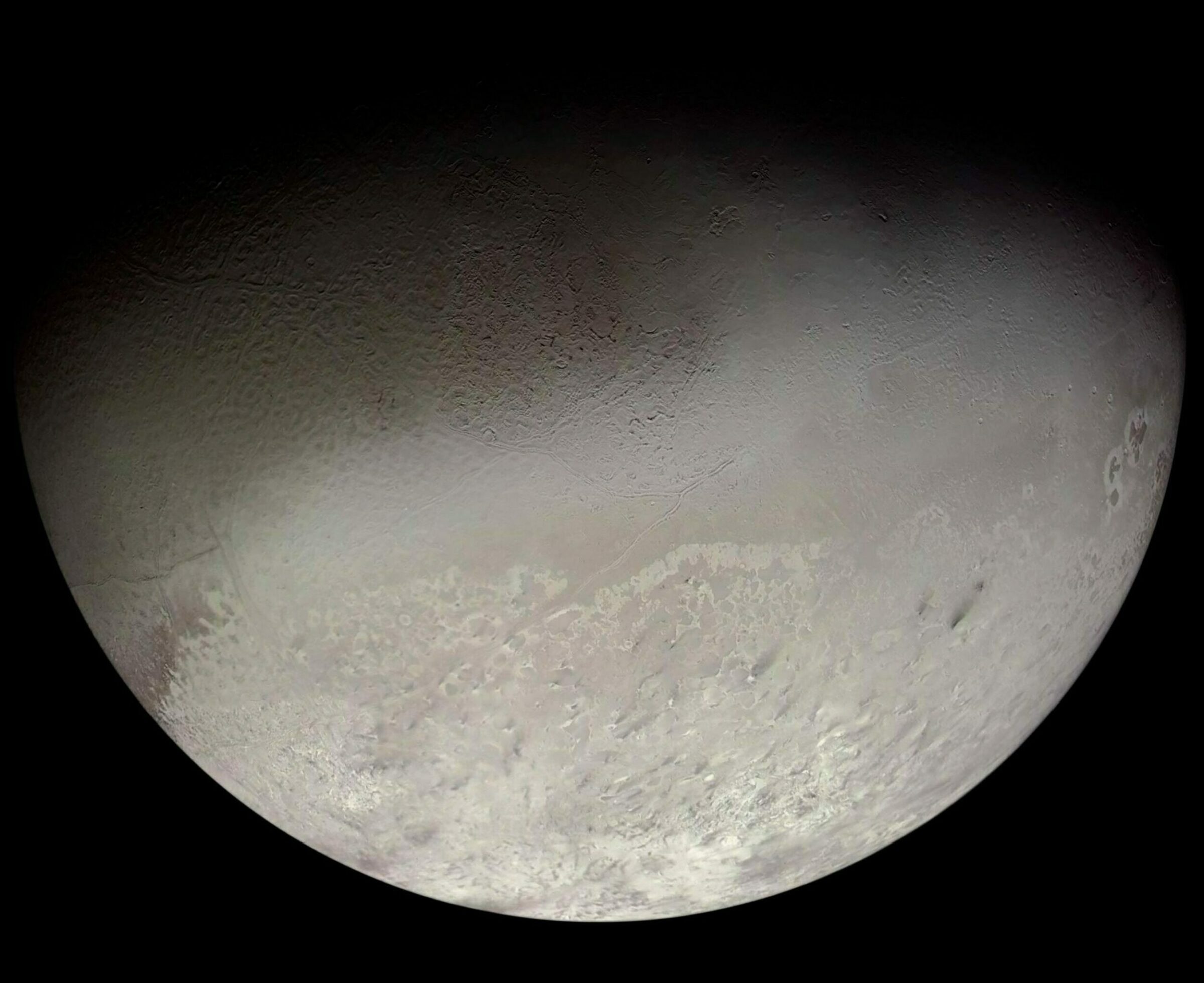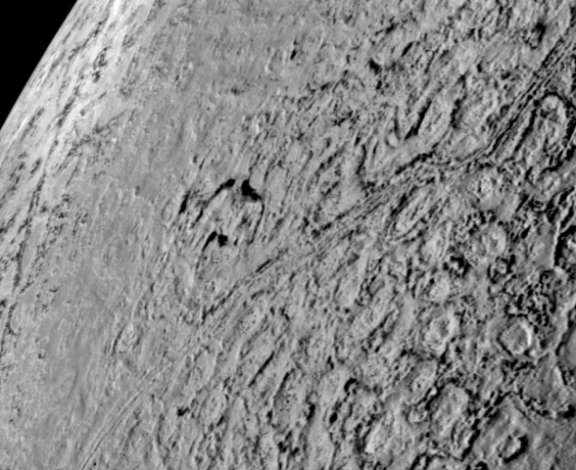Triton, Neptune's largest moon
Highlights
- Triton is the largest of Neptune’s 14 known moons.
- The icy world is likely a Kuiper Belt Object that was captured by Neptune’s gravity.
- Triton may have a liquid water ocean beneath its surface, but a new mission is needed to investigate further.
It’s cold and dim in the Solar System’s suburbs. Triton, the largest of Neptune’s 14 known moons, gets 900 times less sunlight than Earth, and much of that light reflects off the icy world’s surface. This makes Triton one of the chilliest places in the solar system, with temperatures that plunge to -240 degrees Celsius (-400 degrees Fahrenheit).
In spite of the cold, Triton is an active world. It has very few craters, pointing to a young surface that is being constantly reshaped. Dark volcanic plumes erupt all over Triton’s Southern Hemisphere and could be linked to an underground liquid water ocean.
Scientists think Triton probably came from the Kuiper Belt, a band of icy objects beyond Neptune that includes Pluto. Neptune’s gravity may have pulled Triton into its orbit long ago. Triton is sometimes compared with Pluto: the two worlds have similar masses, diameters, and surface materials, although their topographies are somewhat different.
Like many other worlds in our Solar System, Triton has an interesting origin story. The moon was discovered in 1846 by William Lassell, an amateur astronomer who financed his hobby with money made in the brewery business. Laswell found Triton just 17 days after Neptune itself was discovered.
The moon was named after a mythological merman who had the upper body of a human and the lower body of a fish. Triton’s father was Poseidon, also known as Neptune in Roman mythology.

Is Triton a captured Kuiper Belt Object?
It’s very likely. The first piece of evidence is that Triton orbits Neptune the wrong way in what’s known as a retrograde orbit. Like Earth, Neptune spins counterclockwise on its axis. Any moons that formed alongside Neptune should orbit the planet in the same direction.
Simulations show the moon may have had a large companion world similar to Pluto’s Charon. Destined for a tragic parting, the duo may have come barreling through the Neptune system, with Triton on a collision course with Neptune. Triton’s companion may have saved the day by ushering Triton into an orbit that was highly inclined, or tilted, off of Neptune’s equator.
The companion world, unfortunately, would have been tossed out of the solar system. It may still be floating amongst the stars — a darkened world from which the Sun is just one of many points of light.
Triton may have escaped catastrophe when it arrived at Neptune, but it is still facing a grim future: Its retrograde orbit means Neptune’s gravity is slowly pulling it towards the planet. Millions of years from now, gravitational forces will break Triton apart, possibly forming a new Neptunian ring.
The mayhem caused by Triton’s entrance may have flung the moon Nereid — which may also be a captured Kuiper Belt Object — into a highly eccentric orbit. Whereas most moons have roughly circular orbits, Nereid travels nearly seven times as far from Neptune at the long end of its orbit as it does at the short end.
Is Triton an ocean world?
We’re not sure. Triton’s surface is young, less than 100 million years old and possibly less than just 10 million years old. It has very few craters, suggesting that something is constantly reshaping its surface.
The reshaping could be caused by volcanic plumes. NASA’s Voyager 2 spacecraft saw more than 120 dark streaks on Triton when it flew past the moon in 1989. These streaks, which are probably a mix of nitrogen, methane, and dust, likely came from past subsurface eruptions. Voyager 2 also spotted at least two plumes that were actively erupting. One plume was eight kilometers (five miles) tall.
What causes Triton’s plumes? There are three main hypotheses:
- Sunlight heats and pressurizes dark patches of nitrogen beneath Triton’s translucent surface ice, until the nitrogen bursts free.
- Heat from within Triton melts pockets of nitrogen ice, which finds its way to the surface and erupts.
- The plumes are cryovolcanoes fed from a subsurface liquid water ocean, or from pockets of liquid water locked within Triton’s icy crust.
The last possibility is the most intriguing, and would make Triton an ocean world. If an ocean exists, it may have been created during the intense gravitational stresses and heating Triton experienced when it was captured by Neptune. The only way to know for sure is a new mission to Triton.
Triton facts
- Surface temperature: -235 degrees Celsius (-391 degrees Fahrenheit)
- Average distance from Sun: 4,495 million kilometers (2,793 million miles), or 30 times farther from the Sun than Earth
- Diameter: 2,700 kilometers (1,680 miles)
- Volume: 10.4 billion cubic kilometers (2.5 billion cubic miles), Triton could fit inside Earth’s moon about two times
- Gravity: 0.78 m/s2 (8% of Earth’s gravity)
- Solar day: 5.9 Earth days
- Atmosphere: Extremely thin, mostly nitrogen with small amounts of methane
Past missions to Triton
Only one spacecraft has ever visited Triton. Voyager 2 flew through the Neptune system on Aug. 25, 1989.
Voyager 2 skimmed over Neptune’s north pole, using the planet’s gravity to bend its trajectory towards Triton. It flew by Triton about five hours later, imaging the surface from a distance of 40,000 kilometers (25,000 miles) — barely higher than the altitude of Earth’s geostationary communications satellites.
Because of Triton’s high-inclination orbit around Neptune, its poles swap time in the Sun, causing dramatic seasonal changes. Voyager 2 only saw the moon’s Southern Hemisphere, which was flecked with dark streaks. The plumes the spacecraft saw were first-ever detected on an icy world. Closer to the equator, Triton’s ice shell gives way to wrinkled terrain resembling a cantaloupe.
Triton was the final world explored by the Voyager program. After the encounter, Voyager 2 joined Voyager 1 in sailing onward towards interstellar space.

Future missions to Triton
The best near-term hope for a NASA mission to Triton comes from the agency’s low-cost, competitively selected Discovery program. A mission called Trident was one of four finalists during the last Discovery selection round. Trident was ultimately passed over in favor of two Venus missions. NASA accepts new Discovery proposals roughly every four years, meaning a new call could come as early as 2022.
There is less hope for Triton through NASA’s higher-cost mission programs. Unlike Discovery missions, the agency’s Flagship and New Frontiers missions are constrained to recommendations made by the Decadal Survey. This report, authored by the scientific community every 10 years, outlines important planetary science questions and a prioritized list of missions to answer them.
For New Frontiers missions, the 2023 Decadal Survey doesn’t allow for a Neptune-Triton mission until three proposal cycles from now. Prospects aren’t much better for Flagship missions: the 2023 survey prioritized a mission to Neptune’s neighbor, Uranus. Next up is a mission to Enceladus, followed by a list of possible missions that includes a journey to Neptune and Triton.
It may seem like the odds for exploring Triton’s mysterious dark plumes are slim, but don’t despair: China is considering a Neptune mission that would launch in 2030 and arrive by 2040. The spacecraft would enter polar orbit around Neptune and deploy two small satellites. One satellite is classified as a “penetrator,” meaning it could slam into Triton’s crust like a dart, giving us our first up-close readings of the icy world’s surface.


 Explore Worlds
Explore Worlds Find Life
Find Life Defend Earth
Defend Earth


